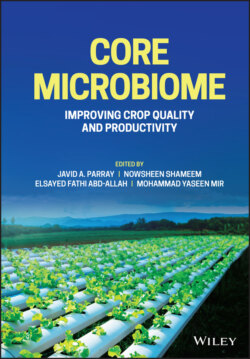Читать книгу Core Microbiome - Группа авторов - Страница 47
3.4 Microbe-Mediated Mitigation of Abiotic Stresses
ОглавлениеCrop plants need to manage external environment pressure exerted by edaphic factors with intrinsic biological mechanisms, as a result of which growth, development, and productivity fail. Microorganisms are the natural populations of complex environments that have various metabolic abilities to mitigate abiotic stresses. Plant–microbe interaction comprises a complex mechanism within the plant cellular system that modulates local and systemic mechanisms in plants to offer defense under adverse conditions (Meena et al. 2017). Many microbes have genetic and metabolic abilities to mitigate abiotic stresses in plants (Gopalakrishnan et al. 2015). The most important rhizosphere inhabitants comprise Pseudomonas (Sorty et al. 2016), Azotobacter (Sahoo et al. 2014), Pantoea (Sorty et al. 2016), Enterobacter (Nadeem et al. 2014), Burkholderia (Ait Barka et al. 2006), Trichoderma (Ahmad et al. 2015), and cyanobacteria (Singh et al. 2005), which have been used for plant growth to alleviate multiple abiotic stresses.
A sequence of plant-protective mechanisms was acquired during evolution to combat adverse environmental situations (Yolcu et al. 2012). These processes cause re-programming in the cells to enable repetitive bio-physico-chemical processes regardless of the external situation. Most of the time, plants tend to decrease the burden of environmental stresses with the help of the microbiome residing in the soil (Ngumbi and Kloepper 2016). The application of phytohormones supplementation has been reported to improve plant growth and development as well as metabolic activity under stressful conditions. Root microbes are very important for managing target metabolism and induced host tolerance against abiotic stress in medicinal plants (Egamberdieva et al. 2017).
In addition to the stress-tolerant microorganism’s application selection, screening might be a good option to overcome stress limitation in crop plants. Indian mustard (Brassica juncea) oil contents were improved in NaCl-affected soil by Trichoderma harzianum application. It improves essential nutrients, triggers antioxidants accumulation and osmolytes while decreases Na+ uptake (Ahmad et al. 2015). Pseudomonas sp. and Acinetobacter sp were reported to enhance the production of indole acetic acid (IAA) and 1-aminocyclopropane-1-carboxylic acid deaminase (ACC) in barley and oats in salt-affected soil.
